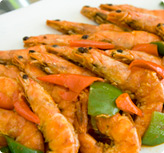Shrimp Science
Nutritious Shrimp
A wonderfully nutritious alternative to meat proteins, the firm, translucent flesh of raw shrimp is an unusually low-fat, low-calorie protein. One four ounce serving of shrimp supplies 23.7 grams of protein (that 's 47.4% of the daily value for protein) in just 112 calories and less than a gram of fat.
As a healthy food choice, shrimp provide a very enjoyable way to get all the benefits of eating fish as often as nutritionists recommend for a healthy, fit lifestyle.
 Shrimp are a very good source of vitamin D, vitamin B12 and an excellent source of selenium and Omega-3 fatty acids. Health benefits:.
Shrimp are a very good source of vitamin D, vitamin B12 and an excellent source of selenium and Omega-3 fatty acids. Health benefits:.
• Vitamin B12 helps prevent heart disease.
• Recent research also shows that vitamin D can offer
significant health benefits, and that many people in
North America do not get enough Vitamin D.
• Omega-3 fatty acids are believed to reduce the risk
of heart disease, some cancers, and to offer some
protection against Alzheimer’s disease.
• Selenium is thought to be important in the prevention of a number of degenerative conditions including cancer, inflammatory diseases, cardiovascular disease, neurological diseases, aging, and infections.
Although shrimp are known to be high in cholesterol, eating shrimp proved, in a controlled scientific study to actually raise HDL (good) cholesterol more than LDL (bad) cholesterol, and to lower the amount of dangerous fat in blood.
A wonderfully nutritious alternative to meat proteins, the firm, translucent flesh of raw shrimp is an unusually low-fat, low-calorie protein. One four ounce serving of shrimp supplies 23.7 grams of protein (that 's 47.4% of the daily value for protein) in just 112 calories and less than a gram of fat.
As a healthy food choice, shrimp provide a very enjoyable way to get all the benefits of eating fish as often as nutritionists recommend for a healthy, fit lifestyle.
 Shrimp are a very good source of vitamin D, vitamin B12 and an excellent source of selenium and Omega-3 fatty acids. Health benefits:.
Shrimp are a very good source of vitamin D, vitamin B12 and an excellent source of selenium and Omega-3 fatty acids. Health benefits:.
• Vitamin B12 helps prevent heart disease.
• Recent research also shows that vitamin D can offer
significant health benefits, and that many people in
North America do not get enough Vitamin D.
• Omega-3 fatty acids are believed to reduce the risk
of heart disease, some cancers, and to offer some
protection against Alzheimer’s disease.
• Selenium is thought to be important in the prevention of a number of degenerative conditions including cancer, inflammatory diseases, cardiovascular disease, neurological diseases, aging, and infections.
Although shrimp are known to be high in cholesterol, eating shrimp proved, in a controlled scientific study to actually raise HDL (good) cholesterol more than LDL (bad) cholesterol, and to lower the amount of dangerous fat in blood.
Defining Shrimp
Most shrimp live in the oceans, swimming close to the sandy bottom or in midwater where there is plenty of plankton to eat. There are even fresh-water shrimp living in estuaries, rivers, and lakes.
Shrimp are swimmers rather than crawlers like their relatives, lobsters and crayfish. They swim forward using the leg-like swimmerets on their abdomens and they use their tails to move backward.
Together with prawns, shrimp are widely caught and farmed for us to enjoy eating.
Shrimp or Prawn?
 What is the difference between a shrimp and a prawn? They look and taste very similar but have different plates—shell segments—on their abdomens.
What is the difference between a shrimp and a prawn? They look and taste very similar but have different plates—shell segments—on their abdomens.
It would make sense to name shrimp and prawn according to science, but here culture is king. In North America, we often use “prawn” to describe any large shrimp, especially those that come 15 (or fewer) to the pound. In Britain the word “prawn” is more commonly used than “shrimp.” Australians use “prawn” for any size or kind of shrimp.
Most shrimp live in the oceans, swimming close to the sandy bottom or in midwater where there is plenty of plankton to eat. There are even fresh-water shrimp living in estuaries, rivers, and lakes.
Shrimp are swimmers rather than crawlers like their relatives, lobsters and crayfish. They swim forward using the leg-like swimmerets on their abdomens and they use their tails to move backward.
Together with prawns, shrimp are widely caught and farmed for us to enjoy eating.
Shrimp or Prawn?
 What is the difference between a shrimp and a prawn? They look and taste very similar but have different plates—shell segments—on their abdomens.
What is the difference between a shrimp and a prawn? They look and taste very similar but have different plates—shell segments—on their abdomens.It would make sense to name shrimp and prawn according to science, but here culture is king. In North America, we often use “prawn” to describe any large shrimp, especially those that come 15 (or fewer) to the pound. In Britain the word “prawn” is more commonly used than “shrimp.” Australians use “prawn” for any size or kind of shrimp.
Shrimp Farming
Shrimp farming is a global industry. Commercial shrimp farming began in the 1970s and production grew rapidly to meet our demand for this succulent sea-food.
About 75% of farmed shrimp come from China and Thailand, and the other 25% comes mainly from Latin America, where Brazil is the largest producer. The largest exporting nation is Thailand, where Thai Gold shrimp are raised, harvested, and frozen to deliver the fresh taste of perfect shrimp to your table.
Technological advances, changes in the industry in the late 1990s, and stronger regulation by governments have led to more sustainable farming practices and a healthier industry. Today you can rely on Tai Foong International’s careful quality control to produce the consistent excellence of Thai Gold shrimp.
Shrimp farming is a global industry. Commercial shrimp farming began in the 1970s and production grew rapidly to meet our demand for this succulent sea-food.
About 75% of farmed shrimp come from China and Thailand, and the other 25% comes mainly from Latin America, where Brazil is the largest producer. The largest exporting nation is Thailand, where Thai Gold shrimp are raised, harvested, and frozen to deliver the fresh taste of perfect shrimp to your table.
Technological advances, changes in the industry in the late 1990s, and stronger regulation by governments have led to more sustainable farming practices and a healthier industry. Today you can rely on Tai Foong International’s careful quality control to produce the consistent excellence of Thai Gold shrimp.